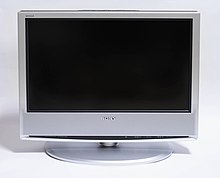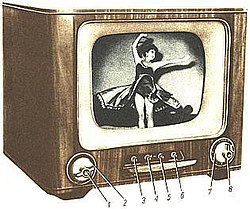TV
The TV. Usually it has a screen and commands or controls. The word comes from the Greek τῆλε ( tēle , ‘far’), and the Latin Visōr (Agent of Videre , ‘see’).
The TV is the final part of the television system, which begins with the capture of images and sounds in origin, and their broadcast and dissemination by different media. The TV has become a usual, daily and normal appliance device with a wide presence in homes around the world. The first commercial television was created on January 26, 1926 by the Scotsman John Logie Baird.
The world's first televisions
The first televisions that can be considered commercial were of the mechanical type and were based on a rotating disc, the Nipkow disc (patented by the German engineer Paul Nipkow in 1884), which contained a series of holes arranged in a spiral and which allowed a "line by line" to a strongly lit image. The resolution of the first mechanical systems was 30 lines at 12 frames but they were later improved to reach hundreds of lines of resolution and even include color.
The mechanical television was marketed from 1928 to 1934 in the United Kingdom, the United States, and the USSR. The first commercial televisions sold by Baird in the UK in 1928 were radios that came with a television attachment consisting of a Neon tube behind a Nipkow disc and produced a postage stamp-sized image, magnified twice by a lens.. The "TV" Baird was also available without radio. The television sold between 1930 and 1933 is considered the first commercial television, reaching several thousand units sold.
The mechanical system was soon displaced by the use of the CRT (cathode ray tube) as an image generating element, which allowed for better resolutions and scanning speeds. Also, by not having mechanical elements, the useful life time was much longer.
The first fully electronic television (without mechanical elements for image generation) with a cathode ray tube was manufactured by Telefunken in Germany in 1934, followed by other manufacturers in France (1936), the United Kingdom (1936) and the United States (1938).
It is estimated that before World War II about 19,000 aircraft were manufactured in the United Kingdom and about 1,600 in Germany.
Already in the early days of the CRT, color transmission systems began to be devised, but it was not until the development of cathode ray tubes with three guns, that fully electronic color televisions began to be mass-produced.
In the 1970s, color televisions became widely available and began to be commercialized in developed countries. The premise of compatibility with monochrome systems allowed both types of televisions to coexist harmoniously to this day.
The electronics of televisions have evolved as electronics in general has advanced. The first televisions used vacuum tubes and later transistors. More recently, integrated circuits began to be used, with some ex-process circuits being developed for specific television functions. At the end of the XX century, image reproduction displays that did not use the CRT began to be developed. In the first decade of the XXI century, the tube disappeared, giving way to televisions with flat screens of different technologies, which still have not achieved an image quality similar to that achieved by the CRT, made it possible to make devices with a much smaller volume, almost bottomless, and with very attractive aesthetic lines that gradually took over the market while manufacturers stopped producing televisions with picture tubes.
The picture tube was replaced by plasma, LCD, led-backlit LCD, and OLED screens, as transmission systems shifted to digital systems, either through cable, satellite, or broadcast distribution. terrestrial through DTT.
At the end of the first decade of the XXI century, with the development of the Internet, connectable televisions appeared and the talk about "hybrid television", which shares conventional reception with access to the network of networks to view audiovisual or any other type of content, opening up new service areas.
3D representation systems (three dimensions) and sound improvements have also been developed. Televisions come to be able to display several different images or content at the same time on their screens and to be able to record content without the need for external elements.
Critical areas in the representation of an image
The representation of an image in any of the technologies used for the screen of televisions and monitors has four critical areas to save, where the results obtained are relevant to the final quality achieved. These areas are:
True Black Reproduction
The difficulty of reproduction of true black is one of the most compromised areas in the representation of an image on a television screen. The low levels of luminance generated by blacks, or very dark gray, are difficult to achieve due to the use of backlight or plasmas barley levels. The dark areas of the images represented lack the rank in the blacks, leaving these annulments (turned into gray) between some levels and others, giving rise to artifice and noise.
TRCs have a minimum level of excitation of luninofosphoros that provide an acceptable black. The same does not happen in the plasmas and even less on the LCD screens, which need back back, which makes it never achieve the dark screen. OLED technology, being each pixel an individual issuer, can reproduce a range of very real blacks, since the emitter is fully turned off.
Color reproduction at low levels of light
Color reproduction in images with areas of very little luminance is one of the most difficult points for the reproduction of an image. In a TV system the color arises from the mixture of three lights corresponding to three different colors (called " primary colors ": red, green and blue). The scarce levels of luminance make this mixture cannot be correct when falling into the nonlinear areas of light emitters.
This phenomenon, closely related to the real reproduction of blacks, precise very linear reproduction systems at the end of low luminance. Plasma and LCD technologies do not have these characteristics by their own technological base, which in the TRC could be found with sufficient efficiency and that OLED technology, for the same reason as the one above, covers in an efficient way.
Width of the dynamic range
For an image to be clear and clear, all levels of light contained in it must be reproduced. Light levels that in the mixture of the three basic colors give the entire range of colors that must be represented.
From the absolute shutdown that provides us with a real black to the ignition in full shine for a target, we have the entire range of levels to be reproduced. The linearity, very critical at the extremes, of the elements that the different technologies use for the representation of the image is the one that gives body to the dynamic range. Cathode ray tubes maintain a characteristic curve, called Gamma, which should be compensated (it is done in the station) to achieve an optimal linear response.
Plasma and LCD systems have a non -linear response and with a very poor contrast ratio which makes their dynamic width small. OLED technology achieves a good result.
Quick response time
Television is a motion image transmission system. The response time of the reproduction screens of the images is essential for the loyalty of what is reproduced.
Quick changes in images must be made so that they do not involve delays and distortions or resolution loss. For this, the persistence and hysteresis times of the elements generating the image are very important. The activation and deactivation times of the light elements are fundamental for a correct representation of the moving image. These times not only depend on the screen technology but also on the signal processing. The concept of change time between two levels of grays, in English Gray-to-Grey Switching Speed is the one that determines this paramenter.
Types
Thanks to advances in display technology, there are now several kinds of modern televisions:
- Cathodic or CRT ray tube: The most common screens are direct vision tubes with which up to 37 inches of diagonal are achieved. Until 2007, they were still the least expensive, and it was a mature technology that could provide great image quality. Since they do not have a fixed resolution, although a minimum resolution, given by the separation between points, can show sources of different resolutions with the best possible image quality. The frequency of a NTSC television is 29,97 Hz, and 25 Hz in the case of PAL standard televisions. The visible vertical resolution of the NTSC televisions is 480 lines, and that of the PALs of 576 lines. The cathodic beam tubes were quite bulky and heavy; they are currently being replaced by Plasma, LCD and more recently LED formats.
- Projection: These are large screen televisions, up to 100 inches diagonal or more. Three types of projection systems are used: with TRC, with LCD, and DLP (with microspecies chip). The retro-projection televisions have existed since the 1970s, but at that time they had no definition of a common television of cathodic rays. Current models have improved a lot, and offer large size at a convenient price. The projection screens do not result in daylight or in bright rooms, so they are more suitable for dark areas.
- Liquid glass screen, plasma u OLED: Current progress allows the manufacture of flat-screen televisions using active matrix liquid glass technology (LCD), or plasma. They are prepared for the high definition with resolutions from 1280×720 pixels to 7680×4320 pixels. These televisions can have only a millimeter of thickness in case of OLED matrices, and can be hung on a wall like a picture or placed on a base. Some models can also be used as computer monitors.
- LED Matrix has become one of the options for outdoor and stadium video, from the advent of ultraluminescent electroluminescent diodes and their respective circuits. LEDs currently create ultra-large scalable displays that other existing technologies cannot match. Besides having low consumption. The initiative has recently been taken to apply this technology to domestic televisions. These acquire different features than those of other screen types. The lower consumption compared to LCD screens, the longer durability, the lower the thickness, as well as the greater contrast are examples of these features. The pioneering company in this commercial area was the South Korean Samsung.
Resolution
Pixel resolution is the number of individual dots called pixels on a given screen. A typical resolution of 720x480 means that the TV screen is 720 pixels horizontally and 480 pixels along the vertical axis. Resolution affects image sharpness. The higher the resolution of a screen, the sharper it is. The first resolution had 48 lines and each of the factories used different systems. The standardization of these systems began in July 1941 when the NTSC system was achieved, valid for all states in the United States, with 325 lines. Europe achieved a 625-line system at the end of the war, France had its own 819-line system, and England maintained its 405-line system. Later the NTSC system was improved.
Controls
- Contrast ratio is a measurement of the interval between the clearest and darkest points on the screen. The higher the contrast, the better the image is seen in terms of its richness, depth and detail in the shadows. The contrast control of a television actually controls the intensity of the image or the brightness.
- The brightness of an image measures the overall brightness of the screen. It's measured in cd/m2{displaystyle cd/m^{2}} equivalent to the amount of candles required to form the image. Brightness control shifts the "black point" or level of shadows, which affects the contrast range or gamma of the image.
During the years immediately after World War II, different experiments were carried out with various television systems in some countries in Europe, including France and the Netherlands, but it was the Soviet Union, which began its regular broadcasts in Moscow in 1948, the first country on the continent to put this public service into operation. Nearly 98% of households in the USSR (3.2 people per receiver) and in France (2.5) own a television, the percentage being 94 in Italy (3.9) and 93 in German households currently part of the reunified Federal Republic of Germany (2.7).
Television in space
TV cameras aboard US spacecraft transmit hitherto inaccessible space information back to Earth. Mariner spacecraft, launched by the United States between 1965 and 1972, sent back thousands of photographs of Mars. The Ranger and Surveyor series relayed thousands of photographs of the lunar surface for scientific analysis and processing prior to the July 1969 crewed moon landing, while millions of people around the world were able to view the color emission directly from the lunar surface.
Since the 1960s, television cameras on orbiting weather satellites have also been widely used. Ground-rigged vidicon cameras record images of clouds and weather conditions during the day, while infrared cameras capture images at night. The images sent by satellites are not only useful for predicting the weather but also for understanding global weather systems. High-resolution vidicon cameras aboard Earth Resource Technology Satellites, also known as ERTS, have been used to conduct surveys of crops, as well as mineral and marine resources.
Contenido relacionado
Lee Marvin
Electromyography
The Battle of the River Plate



